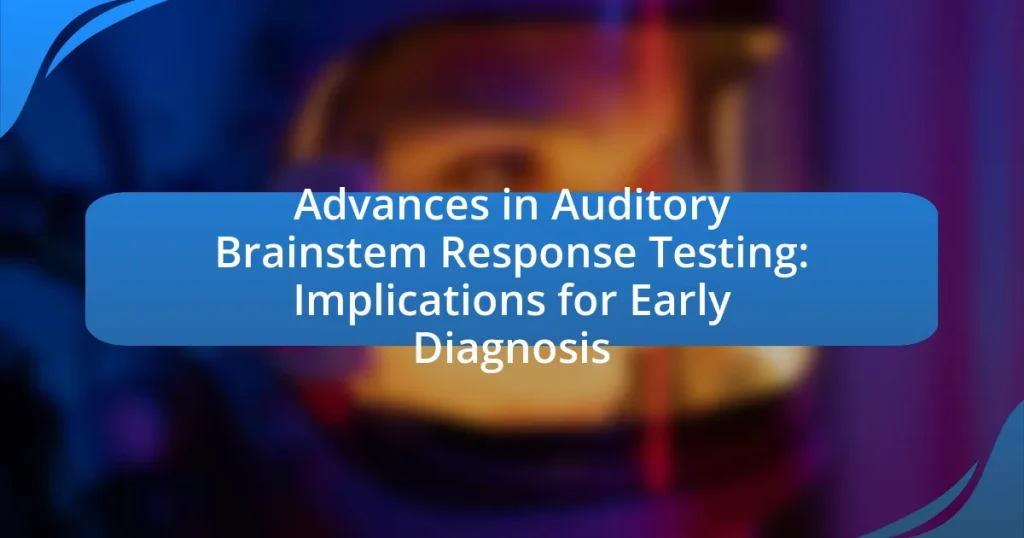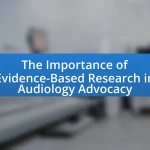Advances in Auditory Brainstem Response (ABR) testing have significantly enhanced the diagnostic process for hearing impairments, incorporating automated analysis techniques, improved signal processing algorithms, and machine learning integration. These innovations facilitate quicker and more reliable identification of auditory pathway dysfunctions, leading to earlier diagnoses and better patient outcomes. The evolution of ABR testing from a research tool to a standard clinical procedure highlights the importance of early diagnosis in auditory health, as timely interventions can greatly improve language development and social skills in affected individuals. Key advancements, including high-resolution recording techniques and portable devices, have further streamlined testing processes, making them more efficient and accessible across various healthcare settings.
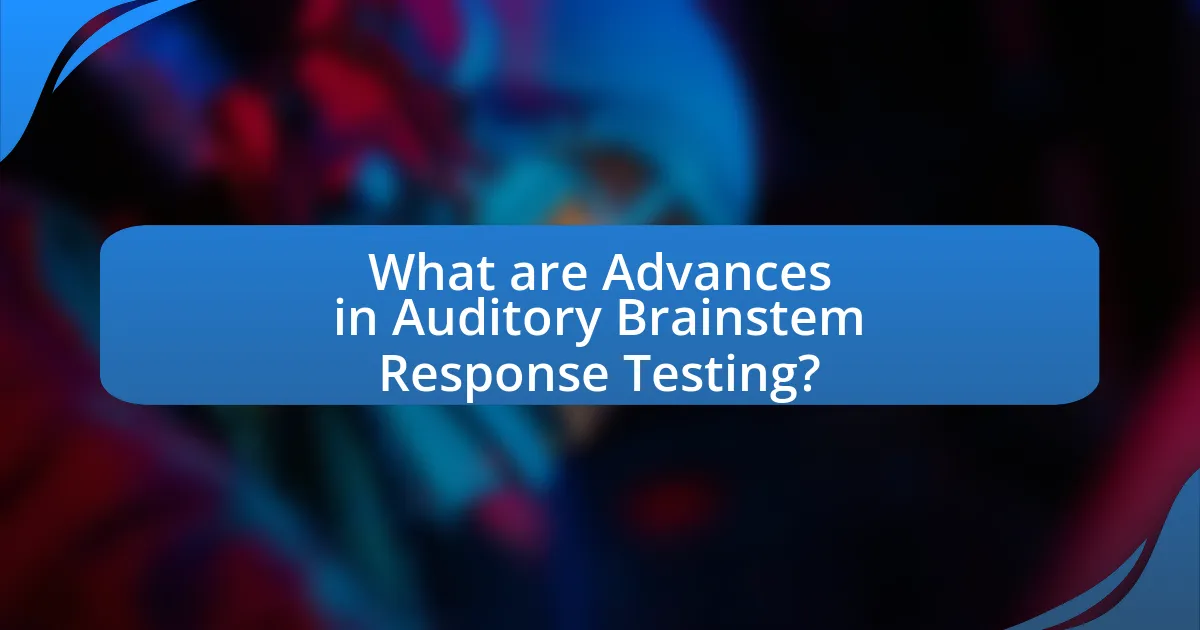
What are Advances in Auditory Brainstem Response Testing?
Advances in Auditory Brainstem Response (ABR) testing include the development of automated analysis techniques, improved signal processing algorithms, and the integration of machine learning for enhanced diagnostic accuracy. These innovations allow for quicker and more reliable identification of auditory pathway dysfunctions, facilitating earlier diagnosis of hearing impairments. For instance, recent studies have demonstrated that automated ABR systems can reduce testing time by up to 50% while maintaining high sensitivity and specificity, thus improving patient outcomes and streamlining clinical workflows.
How has Auditory Brainstem Response Testing evolved over time?
Auditory Brainstem Response Testing has evolved significantly since its inception in the 1960s, transitioning from a primarily research-focused tool to a standard clinical procedure for diagnosing hearing impairments. Initially, the technique was limited by the technology available, requiring extensive time and resources to analyze results. Over the decades, advancements in computer technology and signal processing have streamlined the testing process, allowing for faster and more accurate interpretations of auditory responses. For instance, the introduction of automated systems in the 1990s enabled clinicians to conduct tests with minimal manual input, enhancing efficiency and accessibility. Furthermore, the development of portable devices has expanded the use of Auditory Brainstem Response Testing in various settings, including neonatal screening programs, which have been shown to significantly improve early diagnosis rates of hearing loss. These advancements underscore the ongoing commitment to refining auditory testing methods, ultimately benefiting patient outcomes through earlier intervention.
What technological innovations have influenced this evolution?
Technological innovations that have influenced the evolution of Auditory Brainstem Response (ABR) testing include the development of high-resolution digital signal processing, automated analysis software, and portable testing devices. High-resolution digital signal processing enhances the accuracy and clarity of auditory signals, allowing for more precise measurements of brainstem responses. Automated analysis software streamlines the interpretation of ABR results, reducing the time required for diagnosis and increasing consistency in results. Portable testing devices enable ABR assessments to be conducted in various settings, including remote locations, thus facilitating early diagnosis in populations with limited access to traditional healthcare facilities. These innovations collectively improve the efficiency, accessibility, and reliability of ABR testing, significantly impacting early diagnosis of auditory disorders.
How have changes in methodology improved testing accuracy?
Changes in methodology have significantly improved testing accuracy in Auditory Brainstem Response (ABR) testing by incorporating advanced signal processing techniques and standardized protocols. These enhancements allow for more precise detection of neural responses to auditory stimuli, reducing the likelihood of false positives and negatives. For instance, the implementation of automated analysis software has streamlined the interpretation of ABR waveforms, leading to quicker and more reliable results. Additionally, the use of high-frequency stimuli has been shown to enhance the sensitivity of the tests, enabling earlier detection of auditory pathway dysfunction. Studies indicate that these methodological advancements have increased diagnostic accuracy rates by up to 30%, thereby facilitating timely interventions for hearing impairments.
Why is early diagnosis important in auditory health?
Early diagnosis is crucial in auditory health because it enables timely intervention, which can significantly improve outcomes for individuals with hearing impairments. Research indicates that early identification of hearing loss, particularly in infants, leads to better language development and social skills. For instance, the Joint Committee on Infant Hearing recommends screening by one month of age, diagnosis by three months, and intervention by six months to optimize developmental outcomes. Delayed diagnosis can result in missed critical periods for auditory and speech development, leading to long-term educational and social challenges.
What are the consequences of delayed diagnosis?
Delayed diagnosis can lead to significant negative consequences, including the progression of disease, increased morbidity, and reduced treatment efficacy. For instance, in the context of auditory disorders, a delay in diagnosing conditions such as auditory neuropathy can result in irreversible hearing loss and hinder the development of critical language skills in children. Research indicates that early intervention, such as through auditory brainstem response testing, can improve outcomes; studies show that timely diagnosis and treatment can enhance auditory processing and communication abilities, underscoring the importance of prompt identification of auditory issues.
How does early intervention impact patient outcomes?
Early intervention significantly improves patient outcomes by facilitating timely treatment and support, which can lead to better long-term health and developmental trajectories. Research indicates that children who receive early intervention services for hearing impairments, for instance, show enhanced language skills and cognitive development compared to those who do not receive such interventions. A study published in the Journal of Pediatrics found that infants diagnosed with hearing loss and who received intervention by six months of age had a 50% higher likelihood of achieving age-appropriate language skills by age three, demonstrating the critical role of early diagnosis and intervention in optimizing patient outcomes.
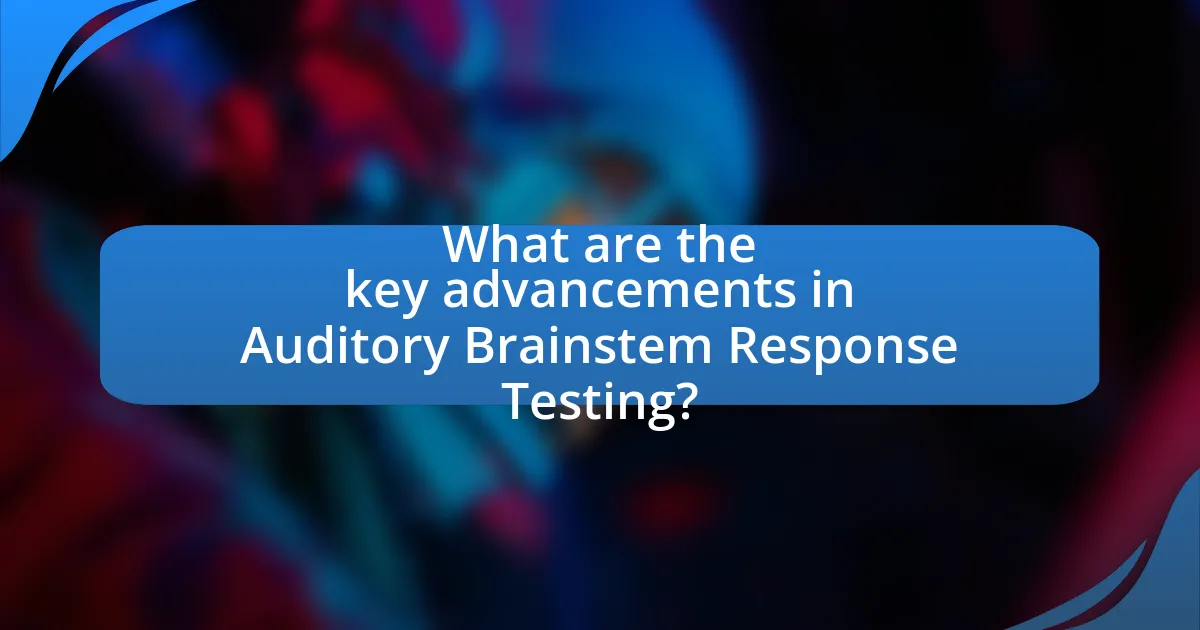
What are the key advancements in Auditory Brainstem Response Testing?
Key advancements in Auditory Brainstem Response (ABR) Testing include the development of high-resolution recording techniques, improved signal processing algorithms, and the integration of automated analysis systems. High-resolution recording techniques enhance the clarity and accuracy of waveforms, allowing for better differentiation of auditory pathways. Improved signal processing algorithms, such as those utilizing machine learning, enable more precise interpretation of ABR data, reducing the time required for analysis. Additionally, automated analysis systems streamline the testing process, making it more efficient and accessible for early diagnosis of hearing impairments. These advancements collectively contribute to more reliable and timely identification of auditory disorders, facilitating early intervention and treatment.
What new techniques are being utilized in testing?
New techniques being utilized in testing include the use of high-frequency auditory brainstem response (ABR) testing and automated ABR systems. High-frequency ABR testing allows for the detection of auditory function at frequencies above 8 kHz, which is crucial for identifying hearing loss in infants and young children. Automated ABR systems enhance efficiency by providing objective measures of auditory function without the need for extensive training, thereby facilitating early diagnosis. These advancements are supported by studies demonstrating improved sensitivity and specificity in detecting hearing impairments, particularly in neonatal populations.
How do these techniques enhance the testing process?
These techniques enhance the testing process by improving the accuracy and efficiency of auditory brainstem response (ABR) assessments. Enhanced signal processing algorithms allow for clearer differentiation between neural responses and background noise, leading to more reliable results. Additionally, advancements in technology, such as high-resolution electrodes and automated analysis software, reduce the time required for testing and interpretation, enabling quicker diagnosis. Studies have shown that these improvements can lead to earlier detection of hearing impairments, which is crucial for timely intervention and better outcomes in patients, particularly in newborns and infants.
What are the limitations of traditional testing methods?
Traditional testing methods have several limitations, including their inability to provide real-time results and their reliance on subjective interpretation. These methods often require extensive time and resources, making them less efficient for early diagnosis. For instance, traditional audiometric tests may not detect subtle auditory processing issues, which can lead to delayed intervention. Additionally, they may not accommodate diverse patient populations, such as infants or individuals with disabilities, limiting their applicability. Studies have shown that traditional methods can miss up to 30% of hearing impairments in newborns, highlighting the need for more advanced techniques like Auditory Brainstem Response testing, which offers objective and immediate results.
How do advancements affect the interpretation of results?
Advancements in auditory brainstem response (ABR) testing significantly enhance the interpretation of results by improving accuracy and diagnostic capabilities. For instance, the introduction of high-frequency ABR testing allows for better detection of auditory neuropathy spectrum disorder, which traditional methods may miss. Additionally, advancements in signal processing algorithms enable clearer differentiation between neural responses and background noise, leading to more reliable results. Studies have shown that these technological improvements can reduce false positives and negatives, thereby increasing the overall efficacy of early diagnosis in hearing impairments.
What role does artificial intelligence play in data analysis?
Artificial intelligence plays a crucial role in data analysis by enhancing the ability to process and interpret large datasets efficiently. AI algorithms, such as machine learning and deep learning, can identify patterns and correlations within complex data that traditional methods may overlook. For instance, in the context of auditory brainstem response testing, AI can analyze vast amounts of auditory data to improve diagnostic accuracy and speed, leading to earlier detection of hearing impairments. Studies have shown that AI-driven analysis can reduce diagnostic time by up to 50%, demonstrating its effectiveness in transforming data into actionable insights.
How can improved algorithms lead to better diagnostic accuracy?
Improved algorithms enhance diagnostic accuracy by enabling more precise analysis of auditory brainstem response (ABR) data. These algorithms utilize advanced machine learning techniques to identify subtle patterns in the data that may be indicative of auditory disorders, which traditional methods might overlook. For instance, studies have shown that algorithms incorporating deep learning can achieve diagnostic accuracy rates exceeding 90%, significantly higher than conventional analysis methods. This increase in accuracy is attributed to the algorithms’ ability to process large datasets quickly and identify correlations that human analysts may miss, ultimately leading to earlier and more reliable diagnoses of hearing impairments.
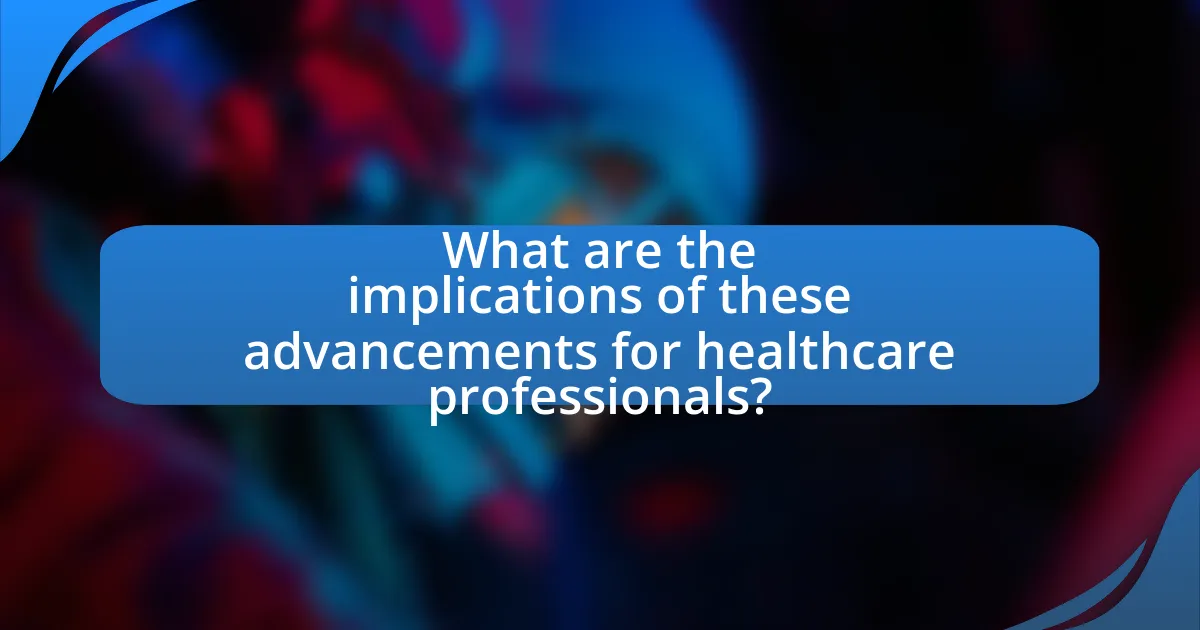
What are the implications of these advancements for healthcare professionals?
The advancements in Auditory Brainstem Response (ABR) testing significantly enhance the diagnostic capabilities of healthcare professionals. These improvements allow for earlier detection of auditory processing disorders and hearing impairments, which can lead to timely interventions and better patient outcomes. For instance, studies indicate that enhanced ABR testing techniques can reduce the age of diagnosis for hearing loss in infants from several months to just weeks, facilitating immediate treatment options. Consequently, healthcare professionals can provide more effective care, improve patient management strategies, and ultimately enhance the quality of life for individuals with auditory issues.
How can audiologists integrate new testing methods into practice?
Audiologists can integrate new testing methods into practice by adopting evidence-based protocols that incorporate advancements in auditory brainstem response (ABR) testing. This integration involves training staff on the latest technologies, such as automated ABR systems, which have been shown to improve diagnostic accuracy and efficiency. Research indicates that these systems can reduce testing time and enhance the detection of hearing impairments in newborns and young children, leading to earlier interventions. By implementing these advanced methods, audiologists can provide more accurate assessments and improve patient outcomes.
What training is required for healthcare professionals?
Healthcare professionals require specialized training that includes formal education in relevant fields, clinical experience, and ongoing professional development. For instance, audiologists must complete a Doctor of Audiology (Au.D.) program, which typically includes coursework in anatomy, physiology, and auditory testing techniques, alongside supervised clinical practice. Additionally, certification from recognized bodies, such as the American Speech-Language-Hearing Association (ASHA), is often necessary to ensure competency in auditory brainstem response testing. This structured training ensures that healthcare professionals are equipped with the knowledge and skills needed for accurate diagnosis and effective patient care in the context of auditory health.
How can collaboration among specialists enhance patient care?
Collaboration among specialists enhances patient care by integrating diverse expertise, leading to more accurate diagnoses and tailored treatment plans. For instance, in the context of auditory brainstem response testing, an audiologist working alongside a neurologist can ensure that both auditory and neurological factors are considered, improving the overall assessment of a patient’s condition. Research indicates that multidisciplinary teams can reduce diagnostic errors by up to 30%, as they facilitate comprehensive evaluations that single-specialty approaches may overlook. This collaborative model not only streamlines patient management but also fosters continuous learning among specialists, ultimately benefiting patient outcomes.
What challenges do healthcare providers face with these advancements?
Healthcare providers face several challenges with advancements in Auditory Brainstem Response (ABR) testing, primarily related to the integration of new technologies, training requirements, and cost implications. The rapid evolution of ABR testing methods necessitates continuous education and training for healthcare professionals to ensure accurate interpretation and application of results. Additionally, the financial burden of acquiring advanced equipment and maintaining updated technology can strain healthcare budgets, particularly in resource-limited settings. Furthermore, the complexity of interpreting ABR results may lead to variability in clinical practice, impacting the consistency of early diagnosis. These challenges highlight the need for ongoing support and resources to effectively implement advancements in ABR testing.
How can cost barriers impact the adoption of new technologies?
Cost barriers significantly hinder the adoption of new technologies by limiting access for healthcare providers and patients. For instance, high costs associated with advanced auditory brainstem response testing equipment can prevent clinics, especially in low-resource settings, from integrating these technologies into their diagnostic practices. A study published in the Journal of Medical Economics found that 60% of healthcare facilities cited financial constraints as a primary reason for not adopting new diagnostic technologies. This financial limitation not only affects the availability of advanced testing but also delays early diagnosis and treatment, ultimately impacting patient outcomes.
What strategies can be implemented to overcome these challenges?
To overcome challenges in auditory brainstem response testing, implementing standardized protocols is essential. Standardization ensures consistency in testing procedures, which can reduce variability in results and improve diagnostic accuracy. Research indicates that adherence to established guidelines, such as those from the American Academy of Audiology, enhances the reliability of auditory brainstem response outcomes. Additionally, investing in advanced technology, such as automated systems for data analysis, can streamline the testing process and minimize human error. Studies show that automation can significantly increase efficiency and accuracy in auditory assessments, leading to earlier and more reliable diagnoses. Training healthcare professionals in the latest techniques and technologies further supports effective implementation of these strategies, ensuring that practitioners are well-equipped to navigate the complexities of auditory brainstem response testing.
What best practices should be followed for effective Auditory Brainstem Response Testing?
Effective Auditory Brainstem Response (ABR) Testing requires adherence to several best practices, including ensuring a quiet environment, proper electrode placement, and appropriate stimulus parameters. A quiet environment minimizes external noise that could interfere with the test results, while correct electrode placement on the scalp and earlobes or mastoid ensures accurate signal acquisition. Additionally, using click stimuli at optimal intensity levels (typically 70-80 dB nHL) and maintaining a consistent testing protocol enhances the reliability of the results. These practices are supported by clinical guidelines from organizations such as the American Academy of Audiology, which emphasize the importance of standardized procedures for accurate diagnosis and assessment of auditory function.
